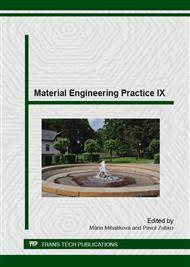p.143
p.147
p.151
p.157
p.161
p.165
p.169
p.174
p.177
Steel KODUR 460MC under Creep Condition
Abstract:
This paper analyses a failure of the micro alloyed steel (Re= 500MPa) at a temperature range 400 - 500 oC in the tensile test conditions and in the creep conditions. The failure character in condition tensile test was changeless and the fraction was transcrystalline ductile. The structure near a fraction showed a considerable deformation texture (reduction of area = 76%). The contraction and the fraction stress considerable was decreased by the increase of the time up to the fraction and the by the increase of temperature in the creep conditions. There were formed secondary intercrystalline cracks except the central crack in the area fraction. Intercrystalline cracks were started step by step to be connected each other. The fraction was started to obtain a mixed status alike and the intercrystalline (creep) fraction part was started to increase.
Info:
Periodical:
Pages:
161-164
Citation:
Online since:
December 2014
Authors:
Keywords:
Price:
Сopyright:
© 2015 Trans Tech Publications Ltd. All Rights Reserved
Share:
Citation:


